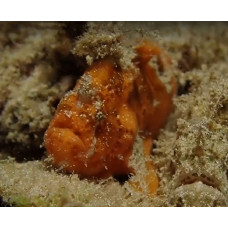Latin name
Antennarius biocellatus
Other name
Brackish water anglerfish, freshwater frogfish twinspot frogfish, fishing frog.
Identification
Antennarius biocellatus has a second dorsal process that is longer than the first, the illicium, and ends in a small protrusion or lure. The second dorsal process is not connected to the head by a ligament. The body is deep and slightly compressed.
Features of fish fins
The second dorsal fin has 12 soft rays, while the anal fin has 6 or 7 soft rays.
Fish colouring
The eye at the base of the posterior part of the dorsal fin is surrounded by a thin pale yellow ring with a black border.
Distribution
Antennarius biocellatus is found in the western Pacific Ocean from Indonesia and the Philippines eastward through New Guinea and the Solomon Islands northward to Taiwan.
Habitat
A marine, tropical, brackish, bottom-dwelling species. It occurs at depths of 0 to 10 m (0 to 33 ft) in estuaries and coastal waters, including reefs. It has been recorded in freshwater.
Size
The maximum published standard length of this species is 5.5 inches (14 cm).
Behavior
This species is unusual among antennariids in that it often inhabits brackish or even completely freshwater environments.
Food and feeding habits
These are predators that sit motionless in ambush and lure prey into their mouths with an esca.
Reproduction
Females lay their eggs in the form of a gelatinous mass or ribbon known as an "egg-raft" or "veil".
Fishing
Not interesting for fishing.
Relationship with a person
Poisonous to eat.
| Classification | |
| Phylum | Chordata |
| Class | Actinopterygii |
| Squad | Lophiiformes |
| Family | Antennariidae |
| Genus | Antennarius |
| Species | A. biocellatus |
| Features | |
| Conservation status | Data Deficient |
| Habitat | Pelagic |
| Life span, years | No information |
| Maximum body weight, kg | No information |
| Maximum length, cm | 14 |
| Sailing speed, m/s | No information |
| Threat to people | Not edible |
| Way of eating | Predator |
Brackish water frogfish
Tags: brackish water frogfish



